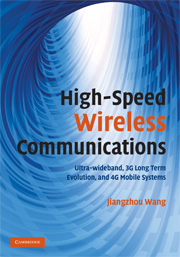Book contents
- Frontmatter
- Contents
- Preface
- Acknowledgements
- List of abbreviations
- Part I Introduction
- Part II UWB communications
- Part III Evolved 3G mobile communications
- Part IV 4G mobile communications
- 9 Optimal and MMSE detection for downlink OFCDM
- 10 Hybrid detection for OFCDM systems
- 11 Coded layered space-time-frequency architecture
- 12 Sub-packet transmission for hybrid ARQ systems
- Index
- References
11 - Coded layered space-time-frequency architecture
from Part IV - 4G mobile communications
Published online by Cambridge University Press: 27 May 2010
- Frontmatter
- Contents
- Preface
- Acknowledgements
- List of abbreviations
- Part I Introduction
- Part II UWB communications
- Part III Evolved 3G mobile communications
- Part IV 4G mobile communications
- 9 Optimal and MMSE detection for downlink OFCDM
- 10 Hybrid detection for OFCDM systems
- 11 Coded layered space-time-frequency architecture
- 12 Sub-packet transmission for hybrid ARQ systems
- Index
- References
Summary
For high-speed OFDM MIMO multiplexing, a new coded layered space-time-frequency (LSTF) architecture (i.e. LSTF-c) with iterative signal processing at the receiver is proposed, where multiple encoders/decoders are designed and each independent codeword is threaded in the three-dimensional (3-D) space-time-frequency (STF) transmission resource array. The iterative receiver structure is adopted consisting of a joint MMSE-SIC detector and the maximum a posteriori (MAP) convolutional decoders. Simulation results show that the proposed LSTF architecture can achieve almost the same performance as the LSTF (i.e. LSTF-a) where single coding is applied across the whole information stream. However, due to its structure of multiple parallel lower speed encoders/decoders with shorter codeword length, the proposed LSTF architecture can be more easily implemented than the LSTF-a.
Introduction
The challenge of the detection of MIMO multiplexing is to design a low complexity detector, which can efficiently suppress multi-antenna interference and approach the interference-free performance. In this chapter, an iterative processing technique for joint detection and decoding is used in the coded MIMO multiplexing. The iterative receiver contains an MMSE-SIC detector [1], the complexity of which is much lower than that of the MAP detector especially when the number of transmit antennas Nt and modulation level are large. As a constituent code, the convolutional code is used due to the computationally efficient SISO MAP decoding. The performances of the joint iterative detection/decoding schemes for both turbo code and convolutional code are quite similar for different numbers of antennas [2], [3].
Information
- Type
- Chapter
- Information
- High-Speed Wireless CommunicationsUltra-wideband, 3G Long Term Evolution, and 4G Mobile Systems, pp. 278 - 295Publisher: Cambridge University PressPrint publication year: 2008
